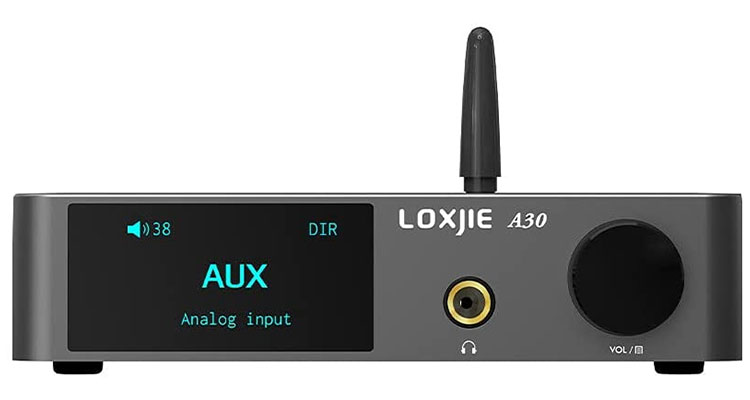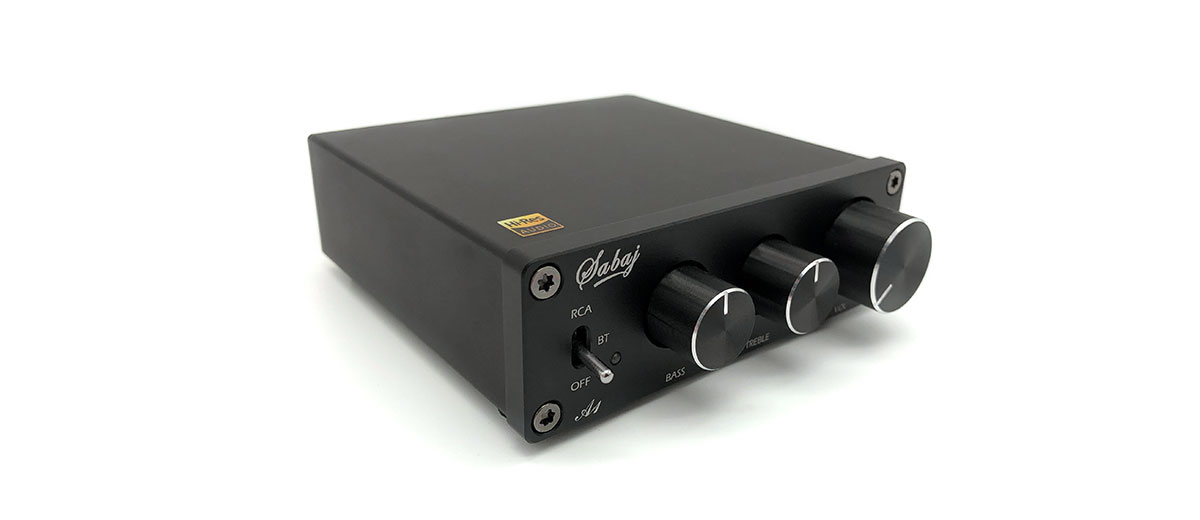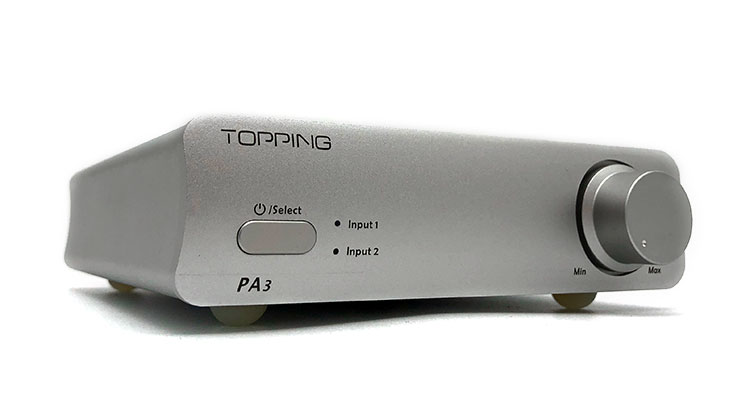Select Comparisons
Topping PA3
$119
Technical
The PA3 is the older of the two devices and uses a TDA7498E Class-D amplifier to generate its 80W per channel output power. With no Bluetooth receiver in sight, it instead features a second RCA input for more ways to interface with other downstream components.
Having built the PA3 with a laundry list of audio-grade components from ALPS, EPCOS, Nichicon, and OMRON, Topping sensibly included a microcontroller unit integrated into the circuitry to protect it from electrical damage as well as save to memory the input selected.
Plus, it also comes with a beefy 32V power supply unit which is not only certified for safety but also maximizes the potential of the amplifier chip.
Design
This arced design language of Topping has been featured in a lot of their other products but it does give off a sense of gentleness to the impression of the device unlike the squared-off corners used by Sabaj. Keeping the face of the PA3 cleaner, only a volume knob and button to change the input is presented.
The rear of the unit is well-spaced making use of its slightly larger working area to distribute the inputs and outputs evenly. Taking a look at the massive 32V PSU explains how Topping managed to keep the unit in such a small form factor.
Performance
Listening to the PA3 is a different experience coming from the well-balanced A1. Immediately, the mids jumped at me with more energy than the rest of its neighbors, muting them in the process.
Having no manual control over the bass, its weaker low-end could use a warmer DAC to make it come alive. Although, the PA3 while similarly lacking in sub-bass is markedly more precise and tighter in creating drums and deep notes.
Its forward midrange levels out poorer recording yet capture more details muted in the A1 enabling more distinct breathiness and character in singers. Piano keys sound fast but reflecting a drier character is not as sweet.
Whistling sounds aren’t fatiguing and simply wash over with enough detail as the treble is more laid back in comparison. Where the PA3 leaves the A1 is in maintaining a stronger impression of placement and layering as supported by a step wider soundstage.

Loxjie A30
$189.99
Technical
Having a headphone section and a host of digital inputs, the similarities in specs between the A30 and the A1 end with both sharing the same MA12070 amplifier from Infineon and a bass/treble adjustment hidden in an extensive menu for Loxjie.
The A30 comes with an ES9023 DAC chip accepting USB, Optical, Coaxial, and Bluetooth 5.0 digital signals. Taking a look at its outputs, it is surprising to see a subwoofer terminal present adding the possibility of extending a two-channel stereo setup into a 2.1 home theater system.
Design
Pulling off a more upscale appearance, the A30 is a strong contender when it comes to building a clean desktop setup. Plus hiding its capabilities inside a low and matte-to-touch chassis, a full-color IPS display elevates the experience with controls that are accessible via the multi-function volume knob or the included remote.
Filling up almost the entire rear of the unit with its long list of inputs and outputs, the A30’s backside is a bit crowded but well-spread and labeled. It manages the space by doubling the right channel RCA input into a coaxial input and switching to a micro-USB from the bigger type B.
Performance
Doubling the price being asked by Sabaj for the A1, the A30 is more mature in technicalities but it also hides a more ‘fun tuning’ inside.
The low-end of the A30 is better collected and faster when compared to the A1’s lack of control affecting instrument placement. More importantly, the mid-bass emphasis given to the A30 puts it on the warmer side of neutral without losing its composure.
Imaged back with the rest of the frequencies but better separated on busier songs and duets, its midrange does not clash and vocals are clean. Male vocals have a lift in the lower mids and females have a smooth and breathy attack.
Snare drums tend towards subdued but have better detail retrieval finally revealing a more accurate sense of space where the recording took place. This plus the wider stage and more vivid imaging makes it a more pleasing amplifier.
Burson Funk
$544
Technical
Putting down a little over $500 for the Funk gets you 3W Class-A headphone amplification and 45W of power for speaker applications running in Class-AB.
The basic package is installed with two NE5532 op-amps which can be swapped with aftermarket chips or with Burson’s V6 Vivid and Classic op-amps.
While it may have a more conservative power rating compared to A1 and other Class-D amplifiers, the pitch of the Funk is to bring a proper Class-AB design inside a chassis fit for desktop applications.
The key to unlocking this challenge is their proprietary Max Current Power Supply (MCPS) removing the need for bigger components necessary in a traditional build.
Design
Burson left the task of tweaking the sound to its swappable op-amps hence the unit also has screws in front and rear giving users access to the circuitry hidden by the aluminum case.
The case not only looks like a heatsink but also performs like one, but to Burson’s credit, they made it part of why the Funk and all of their other products are uniquely attractive.
Having a headphone amp, it features a 6.3mm and 3.5mm jack next to the huge knurled volume wheel prominently placed at the center of the unit giving it a more symmetrical dimension.
Buttons to control the gain and output of the amplifier are located at the right-hand portion of the face.
Having a bigger chassis and no Bluetooth input, there is significantly more space at the rear of the Funk when accessing cables compared to the A1. Also, the binding posts it comes with are larger in comparison adding to a more premium look.
Performance
Both the A1 and the Funk have a softer attack when it comes to bass. However, the Funk has more control over the impact and definition. Prominent bass guitars go deeper in the lower regions with more nuance and better placement.
Putting on a mellow song, the center image is much clearer and is supported by a natural timbre with ethereal air and detail retrieval making it easier to place the weight with sustained vocals.
Strumming and plucking achieve a bold and more gripping sound in contrast to the leaner sound coming from the A1.
While the A1 gives listeners the flexibility to adjust its treble, the Funk comes default with a brighter sound signature giving chimes and effects a free-floating sparkle.
Room size is much more pronounced having a reverberating echo improving on dimensionality plus a wider stage with pinpoint imaging.
Our Verdict
The size and price of the Sabaj A1 shouldn’t be held as an indicator of its capabilities as I was also initially apprehensive that its 80-watt per channel speaker output will not translate effectively.
It lowers the entry barrier to building a decent speaker system with the bonus of good flexibility in gear matching with its granular bass and treble controls.
While it is still challenged in a few key places in the sound department, Sabaj managed to tweak the original enough to bring the latest version up to par with close competitors. And, with the added luxury of Bluetooth capability, this tiny device is introducing a use case some barebones amplifiers do not even have.
Sabaj A1 Amplifier Specifications
- Input: RCA, Bluetooth
- THD+N: 0.005%
- Output Power: 80Wx2 (4Ω) / 40Wx2 (8Ω)
- Input Sensitivity: 190mV
- Input Impedance: 47kΩ
- Power Consumption: 35W (Normal Volume)
- Size: 97*35*118mm
- Weight: 265g







